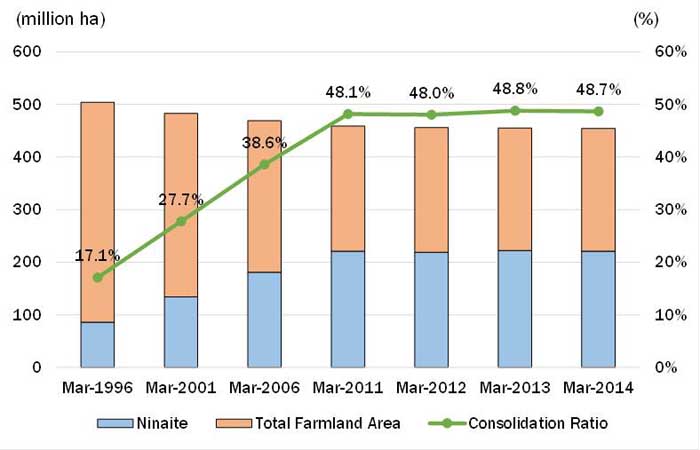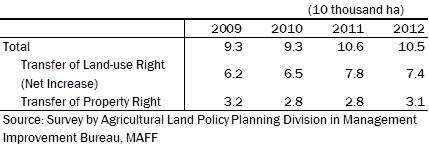INTRODUCTION
Consolidation of farmlands into Ninaite[1] is important challenge for Japanese agriculture, because it can contribute to the improvement of competitiveness of Japanese agriculture in the international market. The Japanese government now promotes farmland consolidation through various policy reforms. For example, there is the amendment of the Agricultural Land Act and the establishment of the Organization for Temporary Farmland Management (OTFM)[2]. The Japanese government sets the target of raising the ratio of farmland consolidation into Ninaite from 49.1% on FY 2010[3] to 80% on FY 2020[4].
In this article, I will translate the Ministry of Agriculture, Forestry and Fisheries (MAFF)’s brief documents in order to review recent farmland consolidation into Ninaite[5]. This translation isn’t the official publication by the MAFF. I did not translate parts of tables and figures to avoid duplication.
TRANSLATION
Summary of Farmland Consolidation into Ninaite
l The farmland area consolidated into Ninaite has increased gradually because of the establishment of the Certified Farmer Scheme on 1993 and “the Super L Fund” limited to certified farmers on 1994. Furthermore, until FY2009, it had continued to increase because of introduction of “the Program to Stabilize Farmer’s Income” on 2007 limited to certified farmers.
l However, after “the Income Support Direct Payment Program for Farmers” was introduced in 2010, the number of certified farmers started to decrease and the farmland area consolidated into Ninaite stopped increasing. This figure is now 2.2million ha on March 2014.
l After the change in government, the Liberal Democratic Party reviewed the above policies and established “the Act for Stabilizing Ninaite Management[6]” on the 2014 National Diet. As this law will introduce “the Scheme for Stabilizing Farmer’s Management” limited to certified farmers after 2015, we can expect that the number of certified farmers will increase. Furthermore, we can expect an acceleration in the speed of the farmland consolidation because of the OTFM which was established on 2014.
l It recently featured the area of farmlands owned or contracted farm operations which have decreased while rented farmlands have increased. This trend is caused by the change of the contract type from farm operations to rented lands which was affected by the additional payment for scale expansion, and by the reduction of owned farmlands which certified farmers cultivated.
l In 2012, the amount of transfers on farmland right was 105,000 ha. This dropped by 1,000 ha from 2011, but still rose compared to the 2009 figure.
l The area of the land-use right (the component of net increase) was 74,000 ha and dropped 1,000 ha. However, comparing with 2010, it rose by 10% due to the additional payment for scale expansion introduced in 2011. We can explain the increase in the transfer of owned farmland by focusing on the transfer of the property right after the elimination of land-use right in Hokkaido.
Reference
Ministry of Agriculture, Forestry and Fisheries (2014) FY 2013 Annual Report on Food, Agriculture and Rural Areas in Japan (Summary).
The Vitality Creation Headquarters of Agriculture, Forestry, Fisheries and Region (2013) Vitality Creation Plan of Agriculture, Forestry, Fisheries and Region (in Japanese).
Table 1. Trend in farmland consolidation into Ninaite

Figure. Trend in Ninaite’s share of farmland (stock)

Table 2. Trend in transfer of farmland right (flow)

[1] Ninaite is a farmer who not only manages large-scale farm units efficiently but also maintains regional society by receiving extra farmlands at the cost of efficiency. By the FY2010 annual report, the MAFF had expressed this terminology as “Principal Farmer”. In the FY2013 report, however, it expresses as “Business Farmer” because it focuses on the former aspect of Ninaite.
[3] The Ministry of Agriculture, Forestry and Fisheries (2014), 10.
[4] The Vitality Creation Headquarters of Agriculture, Forestry, Fisheries and Region (2013), if you wish to read it in English, refer to Dr. Sakuyama’s article on FFTC-AP website.
http://ap.fftc.agnet.org/ap_db.php?id=295
[6] This is not a MAFF’s official translation but a tentative one. MAFF hasn’t published its official translation yet.
|
Date submitted: Feb. 9, 2016
Reviewed, edited and uploaded: Feb. 15, 2016
|


Summary of Farmland Consolidation into Ninaite
INTRODUCTION
Consolidation of farmlands into Ninaite[1] is important challenge for Japanese agriculture, because it can contribute to the improvement of competitiveness of Japanese agriculture in the international market. The Japanese government now promotes farmland consolidation through various policy reforms. For example, there is the amendment of the Agricultural Land Act and the establishment of the Organization for Temporary Farmland Management (OTFM)[2]. The Japanese government sets the target of raising the ratio of farmland consolidation into Ninaite from 49.1% on FY 2010[3] to 80% on FY 2020[4].
In this article, I will translate the Ministry of Agriculture, Forestry and Fisheries (MAFF)’s brief documents in order to review recent farmland consolidation into Ninaite[5]. This translation isn’t the official publication by the MAFF. I did not translate parts of tables and figures to avoid duplication.
TRANSLATION
Summary of Farmland Consolidation into Ninaite
l The farmland area consolidated into Ninaite has increased gradually because of the establishment of the Certified Farmer Scheme on 1993 and “the Super L Fund” limited to certified farmers on 1994. Furthermore, until FY2009, it had continued to increase because of introduction of “the Program to Stabilize Farmer’s Income” on 2007 limited to certified farmers.
l However, after “the Income Support Direct Payment Program for Farmers” was introduced in 2010, the number of certified farmers started to decrease and the farmland area consolidated into Ninaite stopped increasing. This figure is now 2.2million ha on March 2014.
l After the change in government, the Liberal Democratic Party reviewed the above policies and established “the Act for Stabilizing Ninaite Management[6]” on the 2014 National Diet. As this law will introduce “the Scheme for Stabilizing Farmer’s Management” limited to certified farmers after 2015, we can expect that the number of certified farmers will increase. Furthermore, we can expect an acceleration in the speed of the farmland consolidation because of the OTFM which was established on 2014.
l It recently featured the area of farmlands owned or contracted farm operations which have decreased while rented farmlands have increased. This trend is caused by the change of the contract type from farm operations to rented lands which was affected by the additional payment for scale expansion, and by the reduction of owned farmlands which certified farmers cultivated.
l In 2012, the amount of transfers on farmland right was 105,000 ha. This dropped by 1,000 ha from 2011, but still rose compared to the 2009 figure.
l The area of the land-use right (the component of net increase) was 74,000 ha and dropped 1,000 ha. However, comparing with 2010, it rose by 10% due to the additional payment for scale expansion introduced in 2011. We can explain the increase in the transfer of owned farmland by focusing on the transfer of the property right after the elimination of land-use right in Hokkaido.
Reference
Ministry of Agriculture, Forestry and Fisheries (2014) FY 2013 Annual Report on Food, Agriculture and Rural Areas in Japan (Summary).
The Vitality Creation Headquarters of Agriculture, Forestry, Fisheries and Region (2013) Vitality Creation Plan of Agriculture, Forestry, Fisheries and Region (in Japanese).
Table 1. Trend in farmland consolidation into Ninaite
Figure. Trend in Ninaite’s share of farmland (stock)
Table 2. Trend in transfer of farmland right (flow)
[1] Ninaite is a farmer who not only manages large-scale farm units efficiently but also maintains regional society by receiving extra farmlands at the cost of efficiency. By the FY2010 annual report, the MAFF had expressed this terminology as “Principal Farmer”. In the FY2013 report, however, it expresses as “Business Farmer” because it focuses on the former aspect of Ninaite.
[2] If you are interested in it, refer to my previous article on the FFTC-AP website.
http://ap.fftc.agnet.org/ap_db.php?id=374
[3] The Ministry of Agriculture, Forestry and Fisheries (2014), 10.
[4] The Vitality Creation Headquarters of Agriculture, Forestry, Fisheries and Region (2013), if you wish to read it in English, refer to Dr. Sakuyama’s article on FFTC-AP website.
http://ap.fftc.agnet.org/ap_db.php?id=295
[5] This translation is based on below PDF materials on the MAFF’s website.
http://www.maff.go.jp/j/keiei/koukai/pdf/sutokku.pdf
http://www.maff.go.jp/j/keiei/koukai/pdf/furoh.pdf
[6] This is not a MAFF’s official translation but a tentative one. MAFF hasn’t published its official translation yet.
Date submitted: Feb. 9, 2016
Reviewed, edited and uploaded: Feb. 15, 2016